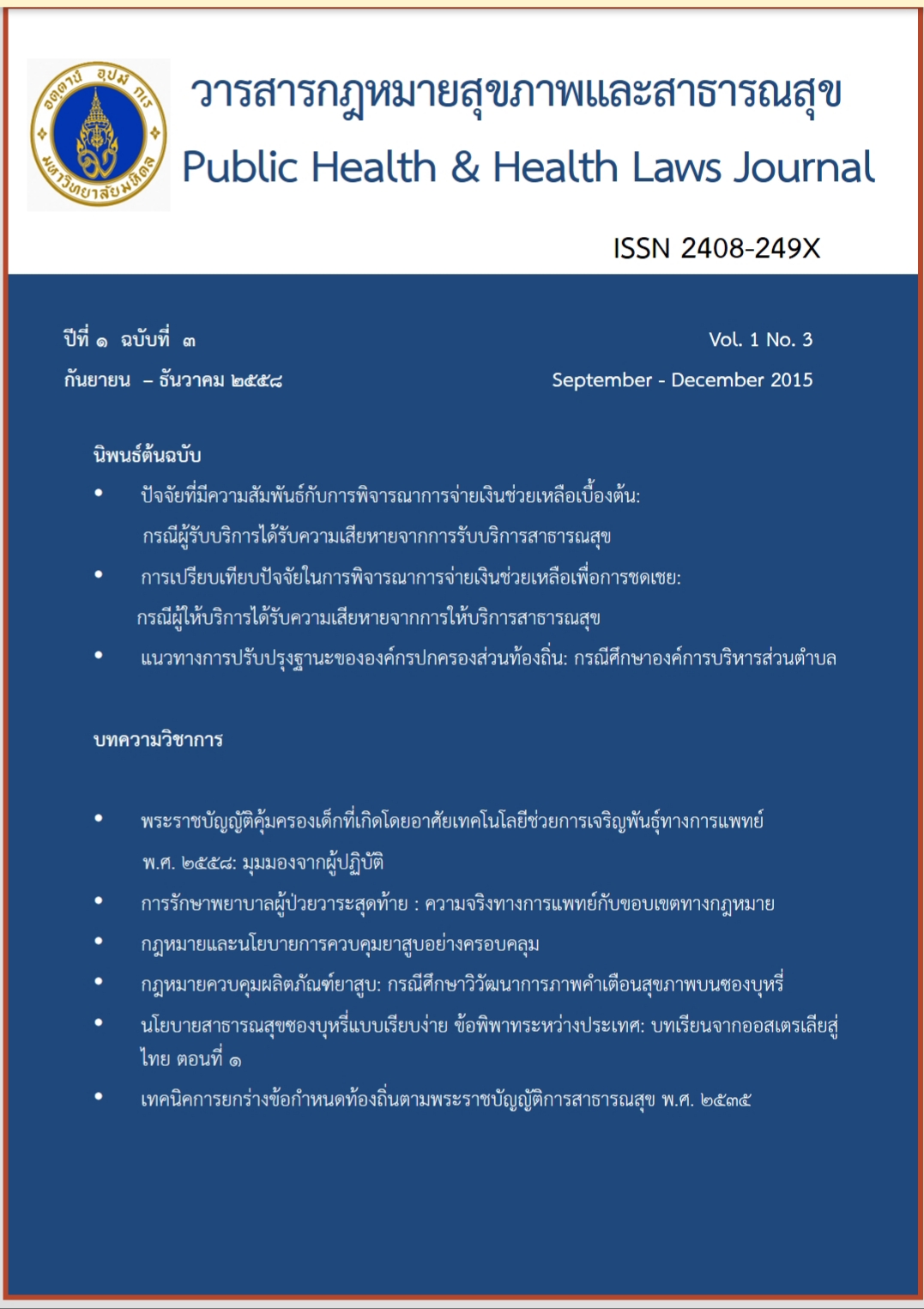Technologically Assisted Reproductive Medicine Surrogate Children Protection Act, B.E. 2558: a view from practitioner
Keywords:
Technologically Assisted Reproductive Medicine Surrogate Children Protection Act, B.E. 2558, artificial insemination, invitro fertilization and embryo transferAbstract
Since Louise Brown, the first embryo fertilized outside the body and returning the embryo into the uterus of the mother (In Vitro Fertilization and Embryo Transfer) was established in 1978, the knowledge and technology of reproductive medicine continues to develop rapidly. This makes possible couples who could not have children in the past, can now have children. But some medical treatments also cause some debate over the legal and ethical issues, such as surrogacy. Thailand has never had laws regulating medical services related to the field of reproductive technology directly, but have 2 medical council announcements, which regulate reproductive technology medical services of medical establishments and medical profession, but cannot control other personnel who are not medical profession. This causes a legal loophole in the case that a foreign spouse hires a Thai woman for surrogacy as a business dealing. Problems follow surrogate children. The National Assembly has passed a law, Technologically Assisted Reproductive Medicine Surrogate Children Protection Act, B.E. 2558. This law was published in the Royal Gazette on May 1, B.E. 2558, which covers regulation and control of medical services related to the technology of reproductive medicine. Moreover, this law indicates legal status of relationship between the child and parents clearly. However, certain requirements of this Act may result in problems in providing medical services and complications for spouses, such as requiring In Vitro Fertilization as a technologically assisted reproductive technology, and artificial insemination can be provided only for legally married spouses only.
References
พระราชบัญญัติวิชาชีพเวชกรรม พ.ศ.2525 และข้อบังคับแพทยสภา. กรุงเทพ; เรือนแก้วการพิมพ์: 2557, น.82-93
พระราชบัญญัติวิชาชีพเวชกรรม พ.ศ. 2525 และข้อบังคับแพทยสภา. กรุงเทพ; เรือนแก้วการพิมพ์: 2557, น.94-98
ประมวลกฎหมายแพ่งและพาณิชย์ [เข้าถึงเมื่อ 1มิ.ย.58] เข้าถึงได้จาก http://law.longdo.com/law/714/
หนังสือพิมพ์
เปิดปมธุรกิจ"อุ้มบุญ"ข้ามชาติเห็นหน้า 5 นาทีก็จากไป. คมชัดลึกออนไลน์. 2554 ก.พ.25; อาชญากรรม : รายงานพิเศษ [เข้าถึงเมื่อ 29 พ.ค.58] เข้าถึงได้จาก http://www.komchadluek.net/detail/20110225/89930/
คู่รักออสซี่จ้างหญิงไทยอุ้มบุญลูกแฝด แต่ทิ้งลูกไว้คนหนึ่งเพราะเป็นดาวน์ซินโดรม.กระปุกดอทคอม.2557 ส.ค.2; ไฮไลท์นิวส์: ข่าวต่างประเทศ [เข้าถึงเมื่อ 29 พ.ค.58] Available from: URL: http://hilight.kapook.com/view/106066
ออสซีฉาวอีกทิ้งเด็กอุ้มบุญในอินเดีย. เดลินิวส์ออนไลน์. 2557 ต.ค.9 [เข้าถึงเมื่อ 29 พ.ค.58] Available from: URL: http://www.dailynews.co.th/foreign/272684
ผงะ พ่อยุ่น 9 ทารก อายุแค่ 24 แฉเผ่นหนีมาเก๊า เผยที่แท้อุ้มบุญ 12 คน!!! . ทรูไลฟ์.2557 ส.ค.8; ข่าวโซ-เชียล [เข้าถึงเมื่อ 29 พ.ค.58] Available from: URL: http://news.truelife.com/detail/3169053#sthash.ilq92tiT.dpuf
ธัญญลักษณ์ เบ็ญจะมโน เตชะวุฒิพันธุ์ (2555). การคุ้มครองเด็กที่เกิดโดยอาศัยเทคโนโลยีช่วยการเจริญพันธุ์ทางการแพทย์ : ศึกษาเปรียบเทียบจากกฎหมายและคำพิพากษาของประเทศสหรัฐอเมริกา. วารสารกฎหมายเปรียบเทียบ ศาลยุติธรรม 4(1):144-149.
Downloads
Published
How to Cite
Issue
Section
License
Disclaimer and Copyright Notice
The content and information presented in articles published in the Journal of Law and Public Health Policy represent the opinions and sole responsibility of the respective authors. The editorial board does not necessarily agree with or assume any responsibility for the views expressed.
All articles, data, content, images, and other materials published in the Journal of Law and Public Health Policy are the intellectual property of the journal. Any individual or organization wishing to reproduce, distribute, or otherwise use the entirety or any part of such materials must provide proper citation.





